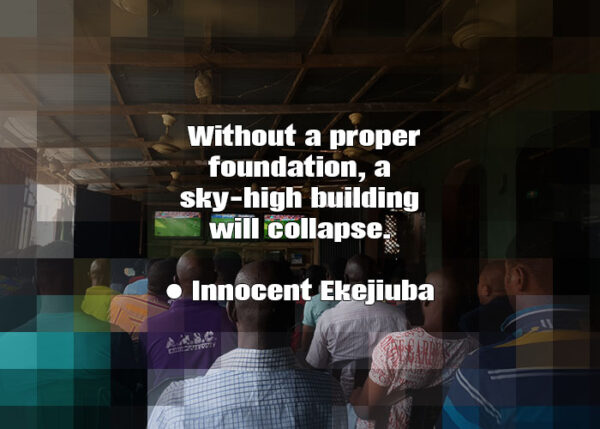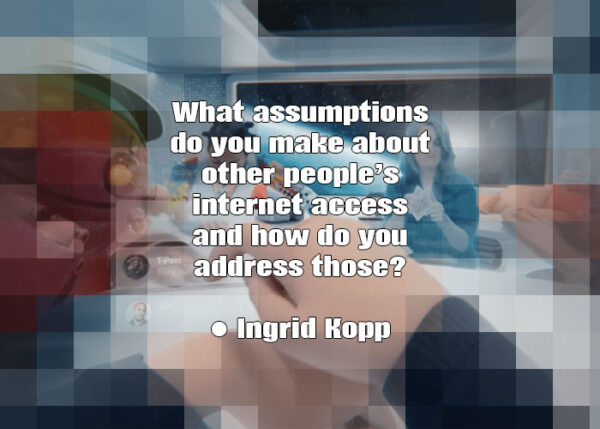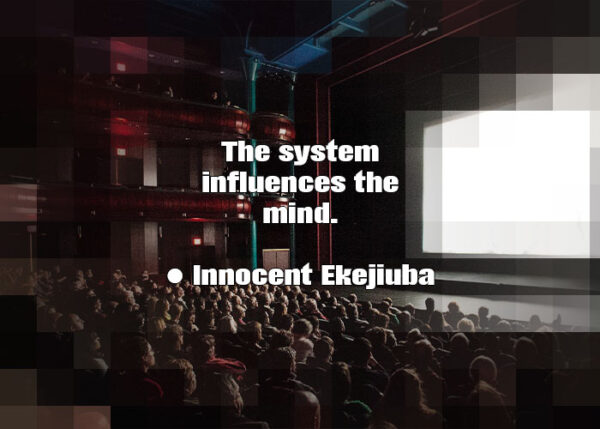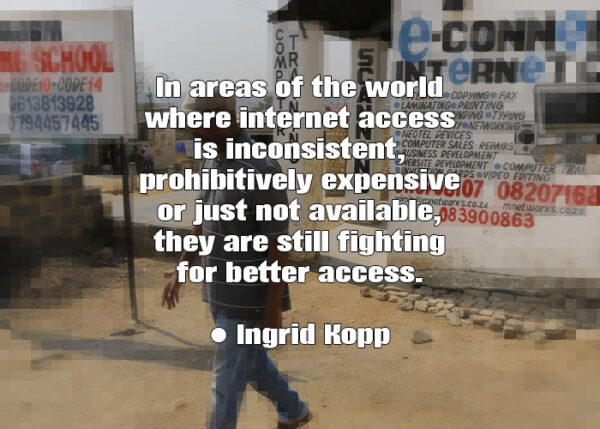Life is increasingly being moved online. If your meetings and classes were not hosted in the digital sphere before, the pandemic made sure they would be. From tech companies to fashion brands, everyone is trying to be the first to jump on the Metaverse bandwagon. This acceleration has begun to highlight the unaddressed problems that the internet brings with it. Not only is it highly energy intensive, it is also unequally divided across the globe. While some are enjoying VR experiences with thousands of people, others are struggling to understand their teachers over connectivity issues, or not even getting the chance to join their lessons at all.
In November 2021, IDFA DocLab hosted DocLab Research & Development sessions during their festival, where experts came together to explore the next steps in immersive technology and media. Together with five other professionals, knowledgable about the topic of design and the internet from varying perspectives, we discussed our visions for a better and lighter internet. Not only focused on energy consumption, our conversations brought attention to the way we relate to the internet, how we are influenced by it, and who can access it and how.
With Web3 on the way, it is vital we start to rethink the way we approach internet infrastructures and the design of our digital platforms, if we want to be inclusive for everyone. We have taken the points that were made during our discussion as guidelines for those who are designing for, and using, the internet of the future—illustrating the relationship between the internet, the environment and accessibility. They are, by far, not enough to make an exhaustive guide, but are still crucial and urgent points and insights to keep in mind.

An introduction to the participants:
Ingrid Kopp of Electric South, a not-for-profit company based in Cape Town, South Africa, that collaborates with artists across Africa in emerging storytelling, through immersive, interactive forms including virtual and augmented reality, and other digital media.
Innocent Ekejiuba, founder of The Drill, an organisation aiming to build a sustainable African art ecosystem, as well as a tech enthusiast, literary critic and media analyst, living and working in Lagos, Nigeria.
Brian Chirls is a creative developer based in New York, currently working on experimental interactive documentary technology, having developed innovative models for interaction, data visualisation and content-authoring in virtual reality.
Angelique Spaninks is the director and curator at MU Hybrid Art House, an art space that crosses boundaries between disciplines, and focuses on the unpredictable future and what role hybrid artists want to take in it.
Pepijn Lemmens, a digital content creative who has worked on ‘the web’ in many different ways, including in his role as an advisor to DEN about the digital transformation of the cultural sector.
The Hmm. You know us.
1: Design globally & locally, vertically & horizontally
There is a continuous need to develop new, better technology—to always go forward and increase the possibilities. This is vertical growth, aiming for the sky. There is little room left to spread out horizontally, and we often forget that in order to have a stable high structure, we need a wide base. Horizontal distribution ensures that technology spreads and adapts itself to a broad audience, so the majority of people can adopt emerging tech. As Innocent has noted: the Western world busies itself mostly with growing vertically, while on the African continent many people strive to make technology as accessible as possible for everyone. For example, movies produced there aren’t exclusive to Netflix but are instead uploaded directly to YouTube, where they are free for everyone. Horizontal growth isn’t about mining the fastest Bitcoin, but showing farmers how to get a loan to repair their property after a flood. Instead of focusing on the next iteration of a product, tech companies should think about how they can reach new audiences that would otherwise get left behind in the race to the sky. A high building without the necessary foundation will collapse.
‘Global’ designs are often limited to a Eurocentric view of the world. For there to be a proper global (or planetary) view, we should spread out the act of designing and making globally. ‘Global’ design will only encapsulate the whole planet when we involve communities everywhere. When the production of code and hardware is spread to places other than those with fast internet access, digital products and platforms will not be centred around massive amounts of bandwidth anymore, and will take into account multiple realities. Different people in different areas understand their own needs best.
As a designer or artist, keep in mind who will see your (online) work, and what they need to enjoy it. Innocent explained how he traveled through the African continent to find a way of showing his work to the general public. He was inspired by ‘football viewing centres’, where people come together to watch football games on multiple big screens. Those people don’t usually own their own television or have an internet subscription to watch football matches. Innocent understood that, for those people to see his work, he needed to bring the work to them, through their own football centres, or to set up his own internet hubs. Don’t leave the responsibility of the experience with the user, but design around their personal conditions and understand how those influence their reception of the work. If you want people with little internet access to see your work, set up hubs they can go to. Understand who your audience is, and how they will access your work. Take away as many barriers as possible for others to reach and connect with you, whether that is internet access, a paywall, or anything else. Imagine each barrier as a plate of glass between your audience and your work. The more glass plates, the more opaque your work becomes and the less interested your audience will be in pursuing the work. And don’t forget, it’s not always necessary to have a design that requires large amounts of bandwidth to access it, something light can be equally interesting.

2: Accessibility from the ground up
Don’t assume your websites or apps will be equally available all over the world. When we design on a lot of bandwidth, it is easy to forget that not everyone will enjoy the same experience. Ingrid, who works a lot with immersive technologies, explained that in the VR social world there are people with standalone Oculus Quests, which you don’t need a high-powered computer to run, and then there are those who are connected to a powerful CPU. They create worlds where they can meet together, and they make sure there are worlds for users with only a Quest, which requires less computational power, and worlds for people with amazing graphic cards. Whatever these worlds are, they guarantee everyone can enjoy something and no one is left out.
Think about the assumptions you make about other people’s internet access. Do you assume everyone has the same fibre optic internet as you, or will they be on 4G, or even limited 3G they will have to top up with data bundles? Understand your own privilege and position when designing. Are you designing only for you and those above you, or are you designing for everyone, even those who have a minimal access to, or knowledge of, the internet? Who do you want to be able to reach?
For many people, accessible code and green code1 is an after-thought when they build a website. The further along you are in designing a website or a product, the harder it becomes to implement accessible and green standards. Keeping these practices in mind from the start makes this process much easier and allows you to create the website you want, without taking away the experience for those with less bandwidth and access, and without unnecessary energy consumption.
We can (and should) create responsive websites, designed for a degrading internet quality, where those with less internet won’t suffer through a poorly loading website, and those with more can enjoy beautiful design. The larger the user’s internet bandwidth, the more JavaScript animations will be visible, but those on 3G can still see a fully functioning HTML website with Times New Roman letters and blue underlined hyperlinks.
3: Beware of the hi-res fetish
We feel like we don’t get the full experience of something if we don’t view it in the highest resolution possible. But often, these high resolutions make something look hyperreal, instead of realistic. It took some getting used to when 4K and 8K first came out, but now we believe this is reality, and what we see on 720p is inferior, let alone 480p, even though things in 8K used to look plasticky and fake.
The system influences the mind. When you are watching a video online, it will automatically try to show you the highest resolution possible for your internet speed, which you then become accustomed to. When a new high-tech item comes out, they advertise it by showing the shortcomings of those before it. You start to believe that the newest thing is the only good thing, it’s either that or nothing. For example, this is institutionalised by film festivals that set certain standards for submitting your work. Standardisation gives a frame for your creation, but it can destroy your creativity. If people and companies only want the ‘best thing’, this becomes the standard everyone reaches for. A competition to attain these standards ensues, instead of ensuring it’s accessible and useful for everyone, and the most fitting format for your project. Just because the highest resolution is available, doesn’t mean we should always want it. But we are not shown the other options outside of the established standards, or we are afraid they will be seen as lesser quality. With less restriction comes more flexibility, and more opportunity to understand what setup works best for you. It is vital to understand what you are trying to say, and to whom, and shape your medium from that.
As designers, artists, and makers, we need to understand why we default to these standards, who sets them, and how they influence us to always want ‘better’ quality, even if it does not always service the image, and even less so an inclusive and sustainable internet. The most important thing is your message and your audience, let those guide what medium and quality you need. How can your audience receive and understand what you are trying to say? Without an audience for your work, you are lost.

4: People are the important network
We use our phones as extensions of ourselves. When we run out of data, we don’t know what to do with ourselves, partly because everyone else is still on their phone. It alienates us from others. We don’t know how to navigate public spaces without a phone anymore. People often talk about how phones have ruined our attention span, but they forget to mention the other losses we have had because of these devices. We don’t navigate the world through people anymore. We don’t ask for directions, one of the simplest moments of human connection, because Google Maps can tell us exactly where we need to go. We never get lost again, and therefore don’t discover new places accidentally. We rely on apps to build the infrastructures around ourselves, but we need to think about what we would do if they didn’t exist.
Build a network of people around you, not just online. We are in touch with the whole world now. It’s easy to talk to anyone across the globe. This makes it simple to forget the people you’re next to. Don’t only concern yourself with ideas and problems on the other side of the world, the people in your community need you too. And when your internet fails, this strong human network is all you have. Create a constellation of relationships, and let them help you get where you need to be. In the end, everyone knows their own world best, because they live in it. Everyone knows someone who knows someone who knows someone. Everything we do affects someone else, we are all connected. Tap into your people network as much, if not more, as your online network.
5: Good technology ≠ bad environment
Technologies are often equated with having a bad influence on the environment. But the internet has also brought us many opportunities to do good. We can share knowledge with each other and we can form communities and help each other out. One of the obvious examples where the internet has a positive impact on the environment is online conferences. It is no longer necessary to fly across the world to be on a one-day panel. However, it is important to keep in mind that unequal internet access plays a role here too. When connecting is the main part of the experience, and you have connectivity issues, what should be frictionless has now become frustrating. Often, those with lesser internet access are not taken as seriously in the group or during a panel discussion, or are scared to speak up in case they won’t be understood. So online conferences are not a perfect concept, but from an environmental viewpoint, they are much better.
New technology does not always equate with a negative environmental impact, in the same way that old technology does not equate with having no impact. Some are quick to say that older systems have not been environmentally conscious either. For example, justifying things like crypto mining by comparing it to the processing power old school credit card systems needed. This ‘what aboutism’ will get us nowhere. Understand that, just because the old system was unsustainable, it does not mean we can still create expendable, environmentally damaging systems without consciousness. We should always strive to be more environmentally mindful.
Good technology is considerate, applicable, adaptable and understands its influence on society (good or bad), and new technologies can prioritise these values when they are developed. But we have to remember, as discussed before, not all new technology is necessary, especially if it doesn’t emphasise on better values. What defines the technology as good or bad is the way we, as designers and developers, can collectively adapt it it to create a more sustainable infrastructure, from the ground up.

6: Understand the intrinsic links between the internet, the environment and accessibility
Ingrid explains that in areas of the world where internet access is inconsistent, prohibitively expensive or just not available, they are still fighting for better access. In these places, mainly in the Global South, people are coming up with innovative ways to use technology with the limited resources they have, while constantly being pressured to be ecologically mindful. They never got the chance to use any technology wastefully before the world decided we needed to be more careful, yet they are suffering the most from the climate change the previous Western extravagance, extraction and exploitation initiated. The environment and the accessibility are interwoven with each other. When we create things that need a lower bandwidth, or reduced processing power, or less hardware, we are simultaneously creating more accessibility and diminishing our climate impact. To be accessible is to be environmentally conscious, and to be environmentally conscious is to be accessible.
References
| ↥1 | Accessible coding is the practice of making your websites usable by as many people as possible, pertaining to people with disabilities, people using a mobile device, or people with a slow network connection. Green coding is the practice of writing code and algorithms that have minimal energy consumption, which can be done with structural (energy related to the code itself) or behavioural (energy related to user scenarios) considerations in mind. |